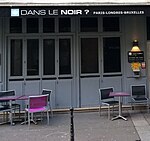Rue des Lombards
Paris road stubsStreets in the 1st arrondissement of ParisStreets in the 4th arrondissement of Paris

The rue des Lombards is a street in Paris, France which is famous for hosting three of the main French jazz clubs: Le Baiser Salé, Le Duc des Lombards and the Sunset/Sunside. It was originally a banking center in medieval Paris, a trade dominated by Lombards merchants, name given from the 12th century onwards to Italian merchants and bankers. It was also shown on the Simpsons episode "To Courier with Love".
Excerpt from the Wikipedia article Rue des Lombards (License: CC BY-SA 3.0, Authors, Images).Rue des Lombards
Rue des Lombards, Paris 4th Arrondissement (Paris)
Geographical coordinates (GPS) Address Nearby Places Show on map
Geographical coordinates (GPS)
| Latitude | Longitude |
|---|---|
| N 48.859305555556 ° | E 2.3491666666667 ° |
Address
Carrefour City
Rue des Lombards 23
75004 Paris, 4th Arrondissement (Paris)
Ile-de-France, France
Open on Google Maps










